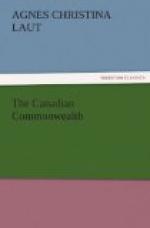Well, here is your country, three thousand by two thousand miles, a great fur preserve. What exists in it? Very little wood, and that small. Undoubtedly some minerals. What else exists? A very sparse population of Indians, whose census no man knows, for it has never been taken; but it is a pretty safe guess to say there are not thirty thousand Indians all told in the north fur country. I put this guess tentatively and should be glad of information from any one in a position to guess closer. I have asked the Hudson’s Bay Company and I have asked Revillons how many white hunters and traders they think are in the fur country of the North. I have never met any one who placed the number in the North at more than two thousand. Spread two thousand white hunters with ten thousand Indians—for of the total Indian population two-thirds are women and children—over an area the size of two-thirds of Europe—I ask you frankly, do you think they are going to exterminate the game very fast? Remember the climate of the North takes care of her own. White men can stand only so many years of that lonely cold, and then they have “to come out” or they dwarf mentally and degenerate.
Take a single section of this great northern fur preserve—Labrador, which I visited some years ago. In area Labrador is 530,000 square miles, two and a half times the size of France, twice the size of Germany, twice the size of Austria-Hungary. Statistical books set the population down at four thousand; but the Moravian missionaries there told me that including the Eskimo who come down the coast in summer and the fishermen who come up the coast in summer the total population was probably seventeen thousand. Now Labrador is one of the finest game preserves in the world. On its rocky hills and watery upper barrens where settlement can never come are to be found silver fox—the finest in the world, so fine that the Revillons have established a fur-breeding post for silver fox on one of the islands—cross fox almost as fine as silver, black and red fox, the best otter in the world, the finest marten in America, bear, very fine Norway lynx, fine ermine, rabbit or hare galore, very fine wolverine, fisher, muskrat, coarse harp seal, wolf, caribou, beaver, a few mink. Is it common sense to think the population of a few thousands can hunt out a fur empire here the size of two Germanies? Remember it was not the hunter who exterminated the buffalo and the beaver and the seal and the otter! The poacher destroyed one group of sea furs; the railway and the farm supplanted the other. West of Mackenzie River and north of British Columbia is a game region almost similar to Labrador in its furred habitat, with the exception that the western preserve is warmer and more wooded. Northward from Ontario is another hinterland which from its very nature must always be a great hunting ground. Minerals exist—as the old French traders well knew and the latter-day discoveries of Cobalt prove—and there is also heavy timber; but north of the Great Clay Belt, between the Clay Belt and the Bay, lies the impenetrable and—I think—indestructible game ground. Swamp and rock will prevent agricultural settlement but will provide an ideal fur preserve similar in climate to Labrador.




